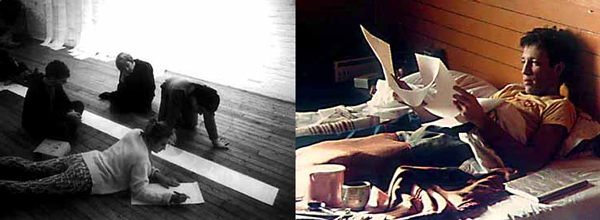La Plissure du Texte
La Plissure du TexteElectra, Musée de l'Art Moderne, Paris, December 11-23 1983
"In 1982 Frank Popper's invitation to contribute to Electra gave me the opportunity to create a telematic event, which somehow might combine the many strands of ideas I have mentioned. Cybernetics, esoterica, interactivity, connected minds, fields of consciousness, narrative centres of action, myth, fairy tales, and a commitment to telematics as my working medium. " (Roy Ascott, Navigating Consciousness: Art and Transformative Technologies

Ascott's La Plissure du Texte (The Pleating of the Text) was produced as part of the Electra exhibition organized in 1983 by art historian Frank Popper at the Musée de l'Art Moderne de la Ville de Paris. La Plissure du Texte allowed Ascott and his collaborators at eleven locations in the US, Canada, Europe, and Australia to experiment with what the artist has termed "distributed authorship". Each remote location represented a character in the "planetary fairytale", and participated in collectively creating and contributing texts and ASCII-based images to the interactive unfolding, or distributed authorship, of the emerging story. Artist Hank Bull, who participated in the event from the Vancouver node, described "the result of this intense exchange" as a "fat tome of Joycean pretensions that delved deep into the poetics of disembodied collaboration and weightless network rambling". He further clarifed this statement, stating, "It was like live radio or performance — that the value lay more in the event, the process, the shared experience of the project, than in the literary quality of the final outcome."
Source: http://telematic.walkerart.org/timeline/timeline_shanken.html

"Over a period of three weeks started a narrative, that could be either in English or in French, it wasn't a matter of translation, had to be just English or French because it was IN Paris, and so forth. To start it off — I played the part of a magician in Paris, so I would naturally say, "Once upon a time”¦" and then others from their point of view-the Wicked Witch or whatsoever — would pick up the narrative, and develop it online. So that what was happening was you would go on line, and you would see the story so far, and then input.
But what happened, which was what I had hoped would happen, was that, for example, in the "Gallery of New South Wales", in Sydney, Australia, every evening people would dress up like witches, and there would be, they'd sort of pull down all this stuff off the web, it would be on a roll in those days, very often printed out, and then pin this up, and a guy would read it out in a tuxedo, read out the story so far, and then they would network amongst themselves, both with people online locally, to develop the story. So a considerably-- an interesting narrative which was very non-linear, was developed through the telematic media. At this point, I decided to commit all my work to it."
Source: Roy Ascott, interviewed by Sabine Breitsameter: http://www.swr.de/swr2/audiohyperspace/engl_version/interview/ascott.html
"The process started by assigning fairy tale roles (centres of action) to eleven cities.
Beast -- Alma, Québec (Langage Plus group)
Villain -- Amsterdam (David Garcia and Annie Wright)
Trickster -- Bristol (Mike Punt and group)
Wise Old Man -- Honolulu (John Southworth and group)
Magician -- Paris (Roy Ascott and group)
Prince -- Pittsburgh (Bruce Breland and group)
Fool --San Francisco (Gregory McKenna and Tom Klinkowstein at La Mamelle)
Witch -- Sydney (Eric Gidney and group)
Fairy Godmother -- Toronto (Norman White and group)
Princess -- Vancouver (Robert Adrian X and group)
Sorcerer's Apprentice -- Vienna (Helmut Mark and Robert Adrian X)
This was to be a project involving multiple associative pathways for a narrative that would unroll in time according to the centres of action that determined its development. The process of pleating the text would be asynchronic, multi-layered, and non-linear in all its bifurcations. Bob Adrian agreed to manage ARTEX as the organising instrument of the communications infrastructure for my project. ARTEX was an electronic mail program for artists on the I.P. Sharp Associates (IPSA) timesharing network.. There was a core of about 10 artists using it regularly and around 30 to 40 others at any one time during its 10 years of operation."
(Roy Ascott, Navigating Consciousness: Art and Transformative Technologies
References:
Comments on the project by Roy Ascott: http://www.olats.org/projetpart/artmedia/2002eng/te_rAscott.html
Overview of the project by Robert Adrian X: http://alien.mur.at/rax/ARTEX/PLISSURE/plissure.html
A version of the final text: http://telematic.walkerart.org/timeline/timeline_ascott.html
A transcript compiled by Norman White at the Toronto node: http://www.normill.ca/Text/plissure.txt
>> Communication Art
Contributors to this page: 1.1
,
joechip
,
irina
and
1.0
.
Page last modified on Monday 17 of September, 2007 09:38:08 CEST by 1.1.
Category:
1966-1999
-
wiki page:
- Büro 1
- Battle of Vukovar
- Ocean Earth Development Corporation
- Peter Fend
- 1989
- 1993
- Airwaves
- Audio Scene 79
- Wiencouver
- 1971
- 1981
- 1979
- 1978
- 1975
- 1973
- Aloha From Hawaii via satellite
- 1974
- 1990
- 1998
- timeline
- 1984
- 1969
- 1980
- 1977
- 1976
- Communication Art
- Ménage à Trois
- 1972
- 1992
- La Plissure du Texte
- 1970
- 1967
- 1963
- V2_East/Syndicate
- 1997
- 1996
- THE THING
- 1983
- 1985
- 1986
- 1994
- 1995
- International Radio Syndicate
- 1991
- ZaMir
- S900
- 1987